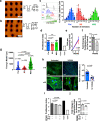Nanotopography reveals metabolites that maintain the immunomodulatory phenotype of mesenchymal stromal cells
- PMID: 36765065
- PMCID: PMC9918539
- DOI: 10.1038/s41467-023-36293-7
Nanotopography reveals metabolites that maintain the immunomodulatory phenotype of mesenchymal stromal cells
Abstract
Mesenchymal stromal cells (MSCs) are multipotent progenitor cells that are of considerable clinical potential in transplantation and anti-inflammatory therapies due to their capacity for tissue repair and immunomodulation. However, MSCs rapidly differentiate once in culture, making their large-scale expansion for use in immunomodulatory therapies challenging. Although the differentiation mechanisms of MSCs have been extensively investigated using materials, little is known about how materials can influence paracrine activities of MSCs. Here, we show that nanotopography can control the immunomodulatory capacity of MSCs through decreased intracellular tension and increasing oxidative glycolysis. We use nanotopography to identify bioactive metabolites that modulate intracellular tension, growth and immunomodulatory phenotype of MSCs in standard culture and during larger scale cell manufacture. Our findings demonstrate an effective route to support large-scale expansion of functional MSCs for therapeutic purposes.
© 2023. The Author(s).
Conflict of interest statement
The authors declare no competing interests.
Figures







Similar articles
-
Adipose tissue-derived multipotent stromal cells have a higher immunomodulatory capacity than their bone marrow-derived counterparts.Stem Cells Transl Med. 2013 Jun;2(6):455-63. doi: 10.5966/sctm.2012-0184. Epub 2013 May 21. Stem Cells Transl Med. 2013. PMID: 23694810 Free PMC article.
-
A Comparison of Phenotypic and Functional Properties of Mesenchymal Stromal Cells and Multipotent Adult Progenitor Cells.Front Immunol. 2019 Aug 28;10:1952. doi: 10.3389/fimmu.2019.01952. eCollection 2019. Front Immunol. 2019. PMID: 31555259 Free PMC article. Review.
-
Mesenchymal stromal cell therapies: immunomodulatory properties and clinical progress.Stem Cell Res Ther. 2020 Aug 8;11(1):345. doi: 10.1186/s13287-020-01855-9. Stem Cell Res Ther. 2020. PMID: 32771052 Free PMC article. Review.
-
Regulatory-compliant conditions during cell product manufacturing enhance in vitro immunomodulatory properties of infrapatellar fat pad-derived mesenchymal stem/stromal cells.Cytotherapy. 2020 Nov;22(11):677-689. doi: 10.1016/j.jcyt.2020.06.007. Epub 2020 Jul 26. Cytotherapy. 2020. PMID: 32723596
-
Mesenchymal Stromal Cells Derived from Dental Tissues: Immunomodulatory Properties and Clinical Potential.Int J Mol Sci. 2024 Feb 6;25(4):1986. doi: 10.3390/ijms25041986. Int J Mol Sci. 2024. PMID: 38396665 Free PMC article. Review.
Cited by
-
Nanotopography Influences Host-Pathogen Quorum Sensing and Facilitates Selection of Bioactive Metabolites in Mesenchymal Stromal Cells and Pseudomonas aeruginosa Co-Cultures.ACS Appl Mater Interfaces. 2024 Aug 21;16(33):43374-43386. doi: 10.1021/acsami.4c09291. Epub 2024 Aug 8. ACS Appl Mater Interfaces. 2024. PMID: 39113638 Free PMC article.
-
Induced Pluripotent (iPSC) and Mesenchymal (MSC) Stem Cells for In Vitro Disease Modeling and Regenerative Medicine.Int J Mol Sci. 2025 Jun 11;26(12):5617. doi: 10.3390/ijms26125617. Int J Mol Sci. 2025. PMID: 40565081 Free PMC article. Review.
-
Cellular Signaling at the Nano-Bio Interface: Spotlighting Membrane Curvature.Annu Rev Phys Chem. 2025 Apr;76(1):251-277. doi: 10.1146/annurev-physchem-090722-021151. Annu Rev Phys Chem. 2025. PMID: 40258240 Review.
-
Biomimetic Dynamics of Nanoscale Groove and Ridge Topography for Stem Cell Regulation.Adv Mater. 2025 Jul;37(30):e2419416. doi: 10.1002/adma.202419416. Epub 2025 Apr 26. Adv Mater. 2025. PMID: 40285558 Free PMC article.
-
Effect of chitin-architected spatiotemporal three-dimensional culture microenvironments on human umbilical cord-derived mesenchymal stem cells.Bioact Mater. 2024 Feb 9;35:291-305. doi: 10.1016/j.bioactmat.2024.01.014. eCollection 2024 May. Bioact Mater. 2024. PMID: 38370866 Free PMC article.
References
-
- Engler AJ, Sen S, Sweeney HL, Discher DE. Matrix elasticity directs stem cell lineage specification. Cell. 2006;126:677–689. - PubMed
-
- McBeath R, Pirone DM, Nelson CM, Bhadriraju K, Chen CS. Cell shape, cytoskeletal tension, and RhoA regulate stem cell lineage commitment. Dev. Cell. 2004;6:483–495. - PubMed
-
- Dalby MJ, et al. The control of human mesenchymal cell differentiation using nanoscale symmetry and disorder. Nat. Mater. 2007;6:997–1003. - PubMed
Publication types
MeSH terms
LinkOut - more resources
Full Text Sources

